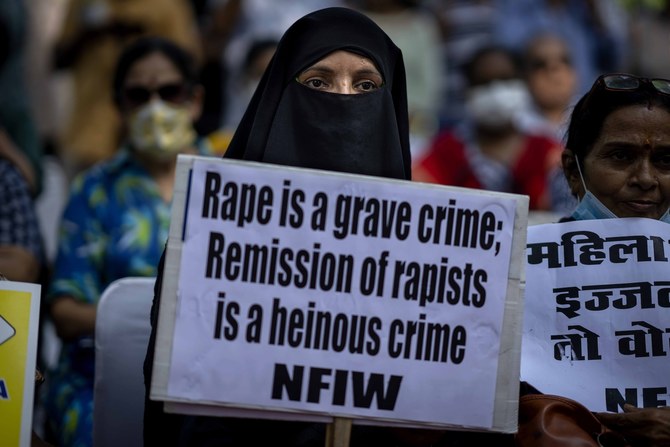
Delhi Commission for Women says rate of sexual assault reaching ‘epidemic proportion’
2012 gang rape and murder in Delhi drew global attention to shocking rates of sexual assault in India
NEW DELHI: Ten years ago, the gruesome gang rape and murder of a young woman in Delhi sent shockwaves around the world, bringing under a spotlight the frightening levels of violence against women in India.
It was the night of Dec. 16, 2012, when 23-year-old Jyoti Singh was brutally assaulted by the driver of a bus she was traveling on and his five accomplices. Tortured with an iron rod, she was thrown naked from the bus to die.
She died two weeks later, at a Singapore hospital, where doctors had been treating her for injuries to internal organs.
While she fought for her life, Singh had identified her attackers and all six were located by police.
BACKGROUND
Jyoti Singh became widely known as Nirbhaya, or Fearless One, and her struggle was a symbol of women’s resistance and mass protests in India throughout 2012, which led to new anti-rape laws that would recognize wider and more nuanced definitions of violence against women.
The oldest man, the 34-year-old bus driver, was never convicted as he reportedly killed himself in custody. The youngest was 17 at the time and was sentenced to three years at a juvenile prison. The other four, aged between 28 and 19, were convicted and sentenced to death and executed by hanging in 2020.
Singh became widely known as Nirbhaya, or Fearless One, and her struggle was a symbol of women’s resistance and mass protests in India throughout 2012, which led to new anti-rape laws that would recognize wider and more nuanced definitions of violence against women. But a decade on, little has changed.
For Singh’s mother, Asha Devi, who has fought to get justice for her killers and to help others, “things have moved from bad to worse” over the years.
“When my daughter’s tragedy inspired nationwide protests, I hoped that no mother would have to suffer like me and see the brutalized body of her daughter. But my hope is dashed with the way violence against women has become a way of life,” she told Arab News.
“Look at the temerity of the boys,” she said, referring to an attack in which three boys poured acid on a teenage girl in New Delhi only this week.
“They did not fear the consequences of such acts. The reason is that the government has not been strict in dealing with cases against women.”
The Delhi Commission for Women requested on Friday a special session of parliament to be dedicated to women’s safety.
“Today the Nirbhaya case completes 10 years. The sad part is that nothing has still changed,” Swati Maliwal, the commission’s chairperson, said in a video message.
“The problems of increasing crime against women and girls have reached an epidemic proportion and the governments are failing to take concrete steps to counter it. Governments have failed to create deterrence.”
Data from India’s National Crime Records Bureau shows that nearly 430,000 cases of crime against women were reported in 2021 — over 40 percent more than a decade earlier. The number is likely to be just the tip of the iceberg as the prevalence of reporting gender-based violence in India remains one of the world’s lowest.
But since the 2012 incident, women have begun to raise their voices, although the “conditions have become worse for women over the years,” said Kawalpreet Kaur, human rights lawyer based in Delhi.
“Despite the escalation in violence, what has changed over a decade is that women have started speaking up and are expressing solidarity with each other,” she told Arab News.
For All India Democratic Women’s Association, which was at the forefront of protests in 2012, there has been no improvement in women’s protection despite the amendment of the law.
“After the Nirbhaya incident, we came out in large numbers. Many women’s movements and democratic forces also came out and continued our protest. The criminal law was amended, but after that, nothing has moved in terms of implementation,” said Maimoona Mollah, one of the association’s most prominent members.
“Be it Hathras, Kathua, or Unnao, in rape cases everywhere the culprits were protected so thoroughly that in no way women could feel safe,” Mollah added, referring to other examples of horrific violence that shook India in the past few years.
In 2020, a 19-year-old Dalit woman was gang raped in the Hathras district of Uttar Pradesh by four upper-caste men. She died two weeks later in a Delhi hospital with her spinal cord severely damaged.
The 2018 Kathua rape case involved the abduction, gang rape and murder of an 8-year-old Muslim girl by seven men near Kathua in Jammu and Kashmir. The accused were Hindu men, including a priest and police officers.
The Unnao rape case was the gang rape of a 17-year-old girl in Unnao, Uttar Pradesh in 2017. A politician from India’s ruling party was convicted of the rape and the murder of the girl’s father.
“The present government has a pompous slogan, ‘Teach daughter, save daughter,’ but things have not improved. The criminals have worked with impunity on all counts because they have protection from the people who should have taken action against them,” Mollah said.
“Our protest and movement and campaign on the issue will continue and we shall continue putting pressure on the authorities and helping society to become more sensitized to women’s issues.”











